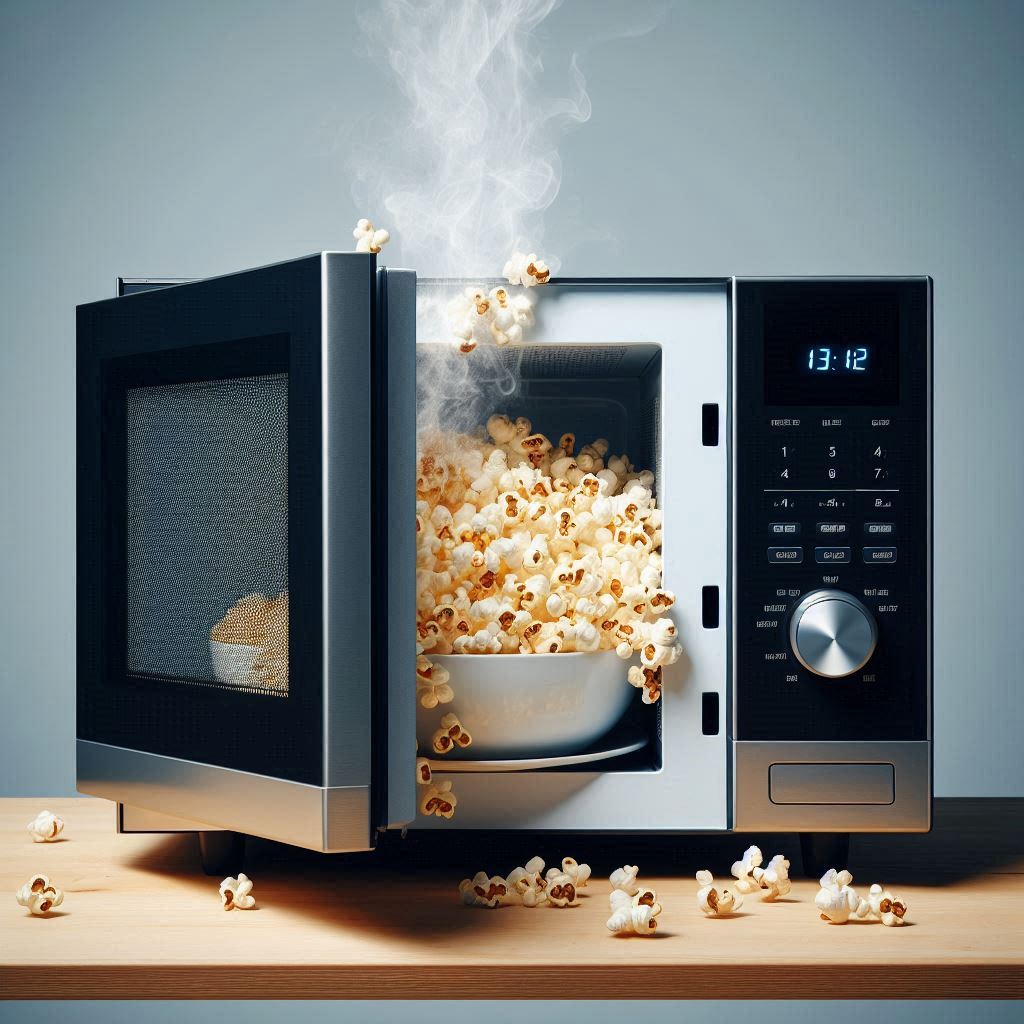THE FASTEST TOOLS IN TOWN
ZIP APPLIANCE REPAIR & SERVICE
Phone: (559) 272-4265
Phone: (559) 272-4265
Appliance Repair Tips For Fresno, CA Residents

Microwave Door Not Sealing Properly? Fix Latch and Seal Issues
Struggling with a microwave door that won’t seal properly? Our guide on fixing latch and seal issues will help you restore your appliance’s efficiency and performance. - Appliance Boss
Introduction
Microwaves are integral to modern kitchens, offering convenience and speed in meal preparation. However, a common issue many encounter is a door that fails to seal properly. This seemingly minor problem can affect the appliance's efficiency and safety. This guide will explore the essential aspects of fixing and maintaining a microwave door to ensure it functions as intended.
Overview of Common Microwave Door Problems
A microwave door that doesn’t seal properly can lead to uneven heating, energy loss, and even potential safety hazards. Common problems include damaged door seals, malfunctioning latches, and misaligned doors. These issues can compromise the microwave’s ability to cook food evenly and safely, making it crucial to address them promptly.

Why a Properly Sealing Door Is Essential
A properly sealing door is vital for several reasons. It ensures that microwave energy is contained within the cavity, preventing leakage that could pose health risks. Additionally, a well-sealing door enhances the efficiency of the microwave, leading to more even cooking and reduced energy consumption. Proper sealing also helps maintain the appliance’s longevity and performance.
Identifying the Problem
Signs of a Microwave Door Not Sealing Properly
Several signs indicate a microwave door is not sealing properly. These include noticeable gaps around the door, uneven cooking, and excessive noise during operation. You might also notice food splatters inside the microwave cavity or steam escaping around the edges of the door.
Common Issues Affecting Microwave Door Seals
The most common issues affecting door seals include wear and tear of the rubber gasket, damage from accidental impacts, or accumulation of food debris that prevents a proper seal. Misalignment of the door or a malfunctioning latch can also contribute to sealing problems.
Understanding Microwave Door Components
The Role of the Door Seal in Microwave Function
The door seal, or gasket, is crucial in preventing microwave radiation from escaping the appliance. It creates a tight barrier around the door’s edges, ensuring that the microwave’s energy remains contained. A well-maintained seal is essential for both safety and efficiency.
How the Latch Mechanism Works
The latch mechanism secures the door in place when the microwave is in operation. It engages with the door strike to keep the door tightly closed. A malfunctioning latch can prevent the door from closing completely, leading to sealing issues.
The Importance of Hinges in Door Alignment
Hinges are responsible for aligning the door properly with the microwave’s body. They allow the door to open and close smoothly and ensure that the door remains correctly positioned. Worn-out or damaged hinges can cause the door to misalign, affecting the seal.
Initial Troubleshooting
Visual Inspection of the Door Seal
Begin by inspecting the door seal visually. Look for any signs of wear, cracks, or gaps. Ensure that the seal is intact and evenly seated around the door’s perimeter.
Checking the Latch for Proper Operation
Test the latch by opening and closing the door. Ensure that it engages properly and holds the door securely in place. If the latch is not functioning correctly, it may need adjustment or replacement.
Examining the Hinges for Wear and Tear
Check the hinges for any signs of damage or wear. Look for loose screws or misalignment. Hinges should operate smoothly and hold the door in the correct position when closed.
Fixing a Damaged Door Seal
How to Identify Damage in the Door Seal
Identify damage by inspecting the seal for tears, cracks, or deformation. A damaged seal can often be felt by running your fingers around the door’s edges.
Step-by-Step Guide to Replacing a Damaged Seal
Remove the Old Seal: Gently pry off the old seal using a flathead screwdriver or similar tool.
Clean the Area: Remove any residue or adhesive from the door.
Install the New Seal: Place the new seal into the groove, ensuring it fits snugly and evenly around the door.
Tips for Proper Seal Installation
Ensure the seal is aligned correctly and seated evenly. Press it into place firmly and check for any gaps. A well-installed seal should create a tight barrier without any visible spaces.
Repairing or Replacing the Latch
Signs of a Faulty Latch Mechanism
A faulty latch may exhibit signs such as difficulty in closing the door, a door that doesn’t stay securely closed, or visible damage to the latch components.
How to Test the Latch Functionality
Test the latch by opening and closing the door repeatedly. Ensure that the latch engages and disengages smoothly without any sticking or resistance.
Instructions for Replacing a Broken Latch
Remove the Old Latch: Unscrew and detach the old latch from its mount.
Install the New Latch: Position the new latch and secure it with screws. Ensure it aligns properly with the door strike.
Test the Door: Open and close the door to verify that the latch functions correctly.
Addressing Misalignment Issues
How to Check Door Alignment
Inspect the door’s alignment by looking at how it sits against the microwave’s body. Check for any uneven gaps or noticeable misalignment.
Adjusting Hinges to Improve Door Fit
If misalignment is detected, adjust the hinges by tightening or loosening the screws. Ensure the door aligns correctly with the microwave’s cavity when closed.
When to Replace Worn-Out Hinges
Replace hinges if they show signs of severe wear, such as rust, bending, or difficulty in moving. Worn-out hinges can cause persistent alignment problems and affect the door’s sealing ability.
Cleaning and Maintenance Tips
Regular Cleaning Practices for the Door Seal
Clean the door seal regularly using a mild detergent and a soft cloth. Avoid abrasive cleaners that could damage the seal. Ensure the seal is dry before closing the door.
Maintaining the Latch and Hinges
Keep the latch and hinges clean and lubricated. Use a silicone-based lubricant to maintain smooth operation and prevent rust or corrosion.
How to Prevent Seal and Latch Issues
Regularly inspect the seal, latch, and hinges for signs of wear or damage. Address any issues promptly to prevent further complications.
Preventing Future Problems
Routine Inspections to Catch Issues Early
Conduct routine inspections of the door seal, latch, and hinges to catch any potential problems early. Regular maintenance can prevent minor issues from becoming major repairs.
Best Practices for Door Use and Care
Avoid slamming the microwave door and be gentle when closing it. Proper use can help extend the life of the door components and maintain a proper seal.
How to Handle Microwave Overuse
Avoid overusing the microwave for extended periods, as this can cause undue stress on the door components and sealing mechanisms.
When to Seek Professional Help
Recognizing When a Professional Is Needed
If you encounter persistent problems with the door seal, latch, or hinges that cannot be resolved with DIY methods, it may be time to consult a professional. Complex issues may require expert diagnosis and repair.
What to Expect from a Professional Inspection
A professional will conduct a thorough inspection of the microwave, identify underlying issues, and recommend appropriate repairs or replacements. Expect a detailed assessment and clear explanations of necessary actions.
Choosing the Right Repair Service for Your Microwave
Select a reputable repair service with experience in microwave repairs. Look for technicians who offer quality service, use genuine parts, and provide transparent pricing.
Cost Considerations
Estimating Costs for DIY Repairs
DIY repairs can be cost-effective, but consider the cost of parts and any tools needed. Weigh the benefits of self-repair against potential risks of incorrect fixes.
Understanding Professional Repair Costs
Professional repair costs vary based on the complexity of the issue, parts required, and labor involved. Obtain estimates from multiple services to ensure fair pricing.
Comparing Costs of Parts vs. Professional Services
Compare the cost of purchasing replacement parts and performing the repair yourself with the cost of hiring a professional. Consider factors such as time, expertise, and potential long-term benefits.
Safety Precautions
Safety Measures for DIY Repairs
When performing DIY repairs, ensure the microwave is unplugged and follow safety guidelines to avoid electrical hazards. Wear appropriate safety gear and handle components carefully.
Handling Electrical Components Safely
Avoid touching electrical components with wet hands or using damaged tools. Ensure that any repairs involving electrical parts are conducted with the power off.
Avoiding Common DIY Mistakes
Double-check your work to avoid common mistakes such as improper seal installation or misalignment. Refer to manufacturer guidelines and instructions to ensure correct procedures.
Conclusion
Summary of Key Fixes for Microwave Door Sealing Issues
Addressing issues with the microwave door seal involves checking and repairing the door seal, latch, and hinges. Regular maintenance and prompt repairs can ensure optimal performance and safety.
Importance of Regular Maintenance and Inspections
Regular inspections and maintenance are crucial for preventing door sealing issues and extending the life of your microwave. Consistent care can help avoid costly repairs and maintain efficient operation.
Final Thoughts on Keeping Your Microwave in Top Condition
By understanding and addressing common door sealing problems, you can ensure that your microwave remains a reliable and effective appliance. Follow best practices for maintenance and seek professional help when needed to keep your microwave in excellent condition.
Zip Appliance Repair and Service is here to help with all your microwave and appliance repair needs. For professional service and expert advice, visit our website at fresno.ziprepairservice.com or call us at (559) 272-4265.

Microwave Door Not Sealing Properly? Fix Latch and Seal Issues
Struggling with a microwave door that won’t seal properly? Our guide on fixing latch and seal issues will help you restore your appliance’s efficiency and performance. - Appliance Boss
Introduction
Microwaves are integral to modern kitchens, offering convenience and speed in meal preparation. However, a common issue many encounter is a door that fails to seal properly. This seemingly minor problem can affect the appliance's efficiency and safety. This guide will explore the essential aspects of fixing and maintaining a microwave door to ensure it functions as intended.
Overview of Common Microwave Door Problems
A microwave door that doesn’t seal properly can lead to uneven heating, energy loss, and even potential safety hazards. Common problems include damaged door seals, malfunctioning latches, and misaligned doors. These issues can compromise the microwave’s ability to cook food evenly and safely, making it crucial to address them promptly.

Why a Properly Sealing Door Is Essential
A properly sealing door is vital for several reasons. It ensures that microwave energy is contained within the cavity, preventing leakage that could pose health risks. Additionally, a well-sealing door enhances the efficiency of the microwave, leading to more even cooking and reduced energy consumption. Proper sealing also helps maintain the appliance’s longevity and performance.
Identifying the Problem
Signs of a Microwave Door Not Sealing Properly
Several signs indicate a microwave door is not sealing properly. These include noticeable gaps around the door, uneven cooking, and excessive noise during operation. You might also notice food splatters inside the microwave cavity or steam escaping around the edges of the door.
Common Issues Affecting Microwave Door Seals
The most common issues affecting door seals include wear and tear of the rubber gasket, damage from accidental impacts, or accumulation of food debris that prevents a proper seal. Misalignment of the door or a malfunctioning latch can also contribute to sealing problems.
Understanding Microwave Door Components
The Role of the Door Seal in Microwave Function
The door seal, or gasket, is crucial in preventing microwave radiation from escaping the appliance. It creates a tight barrier around the door’s edges, ensuring that the microwave’s energy remains contained. A well-maintained seal is essential for both safety and efficiency.
How the Latch Mechanism Works
The latch mechanism secures the door in place when the microwave is in operation. It engages with the door strike to keep the door tightly closed. A malfunctioning latch can prevent the door from closing completely, leading to sealing issues.
The Importance of Hinges in Door Alignment
Hinges are responsible for aligning the door properly with the microwave’s body. They allow the door to open and close smoothly and ensure that the door remains correctly positioned. Worn-out or damaged hinges can cause the door to misalign, affecting the seal.
Initial Troubleshooting
Visual Inspection of the Door Seal
Begin by inspecting the door seal visually. Look for any signs of wear, cracks, or gaps. Ensure that the seal is intact and evenly seated around the door’s perimeter.
Checking the Latch for Proper Operation
Test the latch by opening and closing the door. Ensure that it engages properly and holds the door securely in place. If the latch is not functioning correctly, it may need adjustment or replacement.
Examining the Hinges for Wear and Tear
Check the hinges for any signs of damage or wear. Look for loose screws or misalignment. Hinges should operate smoothly and hold the door in the correct position when closed.
Fixing a Damaged Door Seal
How to Identify Damage in the Door Seal
Identify damage by inspecting the seal for tears, cracks, or deformation. A damaged seal can often be felt by running your fingers around the door’s edges.
Step-by-Step Guide to Replacing a Damaged Seal
Remove the Old Seal: Gently pry off the old seal using a flathead screwdriver or similar tool.
Clean the Area: Remove any residue or adhesive from the door.
Install the New Seal: Place the new seal into the groove, ensuring it fits snugly and evenly around the door.
Tips for Proper Seal Installation
Ensure the seal is aligned correctly and seated evenly. Press it into place firmly and check for any gaps. A well-installed seal should create a tight barrier without any visible spaces.
Repairing or Replacing the Latch
Signs of a Faulty Latch Mechanism
A faulty latch may exhibit signs such as difficulty in closing the door, a door that doesn’t stay securely closed, or visible damage to the latch components.
How to Test the Latch Functionality
Test the latch by opening and closing the door repeatedly. Ensure that the latch engages and disengages smoothly without any sticking or resistance.
Instructions for Replacing a Broken Latch
Remove the Old Latch: Unscrew and detach the old latch from its mount.
Install the New Latch: Position the new latch and secure it with screws. Ensure it aligns properly with the door strike.
Test the Door: Open and close the door to verify that the latch functions correctly.
Addressing Misalignment Issues
How to Check Door Alignment
Inspect the door’s alignment by looking at how it sits against the microwave’s body. Check for any uneven gaps or noticeable misalignment.
Adjusting Hinges to Improve Door Fit
If misalignment is detected, adjust the hinges by tightening or loosening the screws. Ensure the door aligns correctly with the microwave’s cavity when closed.
When to Replace Worn-Out Hinges
Replace hinges if they show signs of severe wear, such as rust, bending, or difficulty in moving. Worn-out hinges can cause persistent alignment problems and affect the door’s sealing ability.
Cleaning and Maintenance Tips
Regular Cleaning Practices for the Door Seal
Clean the door seal regularly using a mild detergent and a soft cloth. Avoid abrasive cleaners that could damage the seal. Ensure the seal is dry before closing the door.
Maintaining the Latch and Hinges
Keep the latch and hinges clean and lubricated. Use a silicone-based lubricant to maintain smooth operation and prevent rust or corrosion.
How to Prevent Seal and Latch Issues
Regularly inspect the seal, latch, and hinges for signs of wear or damage. Address any issues promptly to prevent further complications.
Preventing Future Problems
Routine Inspections to Catch Issues Early
Conduct routine inspections of the door seal, latch, and hinges to catch any potential problems early. Regular maintenance can prevent minor issues from becoming major repairs.
Best Practices for Door Use and Care
Avoid slamming the microwave door and be gentle when closing it. Proper use can help extend the life of the door components and maintain a proper seal.
How to Handle Microwave Overuse
Avoid overusing the microwave for extended periods, as this can cause undue stress on the door components and sealing mechanisms.
When to Seek Professional Help
Recognizing When a Professional Is Needed
If you encounter persistent problems with the door seal, latch, or hinges that cannot be resolved with DIY methods, it may be time to consult a professional. Complex issues may require expert diagnosis and repair.
What to Expect from a Professional Inspection
A professional will conduct a thorough inspection of the microwave, identify underlying issues, and recommend appropriate repairs or replacements. Expect a detailed assessment and clear explanations of necessary actions.
Choosing the Right Repair Service for Your Microwave
Select a reputable repair service with experience in microwave repairs. Look for technicians who offer quality service, use genuine parts, and provide transparent pricing.
Cost Considerations
Estimating Costs for DIY Repairs
DIY repairs can be cost-effective, but consider the cost of parts and any tools needed. Weigh the benefits of self-repair against potential risks of incorrect fixes.
Understanding Professional Repair Costs
Professional repair costs vary based on the complexity of the issue, parts required, and labor involved. Obtain estimates from multiple services to ensure fair pricing.
Comparing Costs of Parts vs. Professional Services
Compare the cost of purchasing replacement parts and performing the repair yourself with the cost of hiring a professional. Consider factors such as time, expertise, and potential long-term benefits.
Safety Precautions
Safety Measures for DIY Repairs
When performing DIY repairs, ensure the microwave is unplugged and follow safety guidelines to avoid electrical hazards. Wear appropriate safety gear and handle components carefully.
Handling Electrical Components Safely
Avoid touching electrical components with wet hands or using damaged tools. Ensure that any repairs involving electrical parts are conducted with the power off.
Avoiding Common DIY Mistakes
Double-check your work to avoid common mistakes such as improper seal installation or misalignment. Refer to manufacturer guidelines and instructions to ensure correct procedures.
Conclusion
Summary of Key Fixes for Microwave Door Sealing Issues
Addressing issues with the microwave door seal involves checking and repairing the door seal, latch, and hinges. Regular maintenance and prompt repairs can ensure optimal performance and safety.
Importance of Regular Maintenance and Inspections
Regular inspections and maintenance are crucial for preventing door sealing issues and extending the life of your microwave. Consistent care can help avoid costly repairs and maintain efficient operation.
Final Thoughts on Keeping Your Microwave in Top Condition
By understanding and addressing common door sealing problems, you can ensure that your microwave remains a reliable and effective appliance. Follow best practices for maintenance and seek professional help when needed to keep your microwave in excellent condition.
Zip Appliance Repair and Service is here to help with all your microwave and appliance repair needs. For professional service and expert advice, visit our website at fresno.ziprepairservice.com or call us at (559) 272-4265.
If your dryer has been giving you problems, contact Zip Appliance Repair & Service at (559) 272-4265

Appliance Repair In A Zip
If you need a dryer repair call our Team at (559) 272-4265, or visit our online scheduling page to request service.
Appliance Repair
HAVE A QUESTION, CALL (559) 272-4265

Online Offers
Take advantage of our online discount offers - save time and money...

Residential & Commercial appliances
See what our company can do for you

Appliance Repair Tips
If your appliance is not working properly...

1405 Commercial Way ste 100
Bakersfield, CA 93309
Lic # 1116346
Equipment We Sevice
- A Call To Confirm Your Appointment Time
- A Email Detailing Your Assigned Technician
- Information Needed Before The Repair Can Be Started
- An Estimate Of Work To Be Done
© 2025 ZIP APPLIANCE REPAIR & SERVICE LLC







